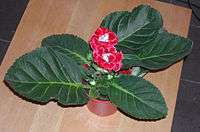Sinningia
| Sinningia | |
|---|---|
| | |
| Sinningia leucotricha | |
| Scientific classification | |
| Kingdom: | Plantae |
| (unranked): | Angiosperms |
| (unranked): | Eudicots |
| (unranked): | Asterids |
| Order: | Lamiales |
| Family: | Gesneriaceae |
| Genus: | Sinningia Nees |
| Synonyms | |
|
Corytholoma | |
Sinningia /sᵻˈnɪndʒiə/[1] is a genus of flowering plants in the family Gesneriaceae. It is named after Wilhelm Sinning (1792-1874), a gardener of the Botanische Gärten der Friedrich-Wilhelms-Universität Bonn.[2] There are about 65 species of tuberous herbaceous perennials, all occurring in Central and South America, with the greatest concentration of species occurring in southern Brazil.

The best-known species, Sinningia speciosa, was originally introduced to cultivation as Gloxinia speciosa and is still commonly known to gardeners and in the horticultural trade as "gloxinia". The true genus Gloxinia is distinguished by having scaly rhizomes rather than tubers.
Sinningia species often grow on rocks or cliffs and most are pollinated by hummingbirds or bees but Sinningia brasiliensis is bat-pollinated, and Sinningia tubiflora, with large, powerfully fragrant tubular white flowers, is apparently pollinated by sphinx moths. Most of the species have large, brightly colored flowers. Because of this, numerous species and numerous hybrids and cultivars are grown as houseplants. A cultivar worth knowing is Sinningia x 'Lovely.' This beautifully gentle plant is a cross between Sinningia sellovii and Sinningia tubiflora. Its tall spikes and tubular flowers attract butterflies, and delight gardeners. Some species with particularly large tubers are cultivated by cactus and succulent enthusiasts as caudiciforms. One such example is Sinningia leucotricha, often listed under the older name Rechsteineria leucotricha and dubbed "Brazilian edelweiss" for its covering of silvery, silky hairs. Other species with large tubers are Sinningia iarae, Sinningia lineata, and Sinningia macropoda.
The hybrid cultivars 'Empress Purple Spotted'[3] and 'Empress Red'[4] have gained the Royal Horticultural Society's Award of Garden Merit.

The Brazilian genera Paliavana and Vanhouttea, consisting of shrubby plants without tubers, are closely related to Sinningia and recent morphological and molecular analyses (Boggan 1991, Perret et al. 2003) suggest that these genera are, in fact, nontuberous Sinningia species. All three genera were included in tribe Gloxinieae in the classification system of Hans Wiehler but are now recognized in their own tribe, Sinningieae.
Numerous genera, including Corytholoma, Rechsteineria and Lietzia, have been synonymized under Sinningia.
Garden Uses and Cultivation
Sinningias are attractive greenhouse plants and houseplants that appeal strongly to gardeners who like to specialize in particular plant groups.The chief environmental needs are warmth, high humidity, suitable soil and good light with shade from strong sun. The soil should be well drained. It should contain a liberal proportion of organic matter, such as leaf mold or peat moss, and enough coarse sand or perlite to ensure good porosity.
Species
Species include:[5]
- Sinningia aggregata (Ker Gawl.) Wiehler
- Sinningia aghensis Chautems
- Sinningia amambayensis Chautems
- Sinningia araneosa Chautems
- Sinningia barbata (Nees & Mart.) G. Nicholson
- Sinningia brasiliensis (Regel & E. Schmidt) Wiehler
- Sinningia bulbosa (Ker Gawl.) Wiehler
- Sinningia canescens (Mart.) Wiehler
- Sinningia cardinalis (Lehm.) H.E.Moore
- Sinningia carolinae (Wawra) Benth. & Hook. f. ex Siebert & Voss
- Sinningia cochlearis (Hook.) Chautems
- Sinningia concinna (Hook. f.) G. Nicholson
- Sinningia cooperi (J. Paxton) Wiehler
- Sinningia discolor (Decne. ex Hanst.) Sprague
- Sinningia douglasii (Lindl.) Chautems
- Sinningia elatior (Kunth) Chautems
- Sinningia eumorpha H.E. Moore
- Sinningia gesneriifolia (Hanst.) Clayberg
- Sinningia gigantifolia Chautems
- Sinningia glazioviana (Fritsch) Chautems
- Sinningia guttata Lindl.
- Sinningia harleyi Chautems
- Sinningia hatschbachii Chautems
- Sinningia helleri Nees
- Sinningia hirsuta (Lindl.) G.Nicholson
- Sinningia iarae Chautems
- Sinningia incarnata (Aubl.) D.L.Denham
- Sinningia insularis (Hoehne) Chautems
- Sinningia kautskyi Chautems
- Sinningia leopoldii (Scheidw. ex Planch.) Chautems
- Sinningia leucotricha (Hoehne) H.E.Moore
- Sinningia lindleyi Schauer
- Sinningia lineata (Hjelmq.) Chautems
- Sinningia macrophylla (Nees & Mart.) Benth. & Hook.f. ex Fritsch
- Sinningia macrostachya (Lindl.) Chautems
- Sinningia magnifica (Otto & A. Dietr.) Wiehler
- Sinningia maximiliana (Hanst.) Benth. & Hook. ex Fritsch
- Sinningia micans (Fritsch) Chautems
- Sinningia nivalis Chautems
- Sinningia nordestina Chautems, Baracho & J.A.Siqueira
- Sinningia × ornata (Van Houtte) H.E. Moore
- Sinningia piresiana (Hoehne) Chautems
- Sinningia polyantha (DC.) Wiehler
- Sinningia pusilla (Mart.) Baill.
- Sinningia reitzii (Hoehne) L.E. Skog
- Sinningia richii Clayberg
- Sinningia rupicola (Mart.) Wiehler
- Sinningia sceptrum (Mart.) Wiehler
- Sinningia schiffneri Fritsch
- Sinningia sellovii (Mart.) Wiehler
- Sinningia speciosa (Lodd.) Hiern
- Sinningia striata (Fritsch) Chautems
- Sinningia tribracteata (Otto & A. Dietr.) Wiehler
- Sinningia tuberosa (Mart.) H.E. Moore
- Sinningia valsuganensis Chautems
- Sinningia verticillata (Vell.) H.E. Moore
- Sinningia villosa Lindl.
- Sinningia warmingii (Hiern) Chautems
References
- ↑ Sunset Western Garden Book, 1995:606–607
- ↑ Genaust, Helmut (1976). Etymologisches Wörterbuch der botanischen Pflanzennamen ISBN 3-7643-0755-2
- ↑ "RHS Plant Selector - Sinningia 'Empress Purple Spotted'". Retrieved 4 July 2013.
- ↑ "RHS Plant Selector - Sinningia 'Empress Red'". Retrieved 4 July 2013.
- ↑ "The Plant List: A Working List of All Plant Species". Retrieved April 15, 2015.
- Boggan, J.K. 1991. 1991. A morphological study and cladistic analysis of Sinningia and associated genera with particular reference to Lembocarpus, Lietzia, Paliavana, and Vanhouttea (Gesneriaceae: Gloxinieae). Thesis, Cornell University, Ithaca, New York, U.S.A. ix + 179 pages, 21 figures. [Copies available at Cornell University and Smithsonian Institution libraries.]
- Perret, M., A. Chautems, R. Spichiger, G. Kite, & V. Savolainen. 2003. Systematics and evolution of tribe Sinningieae (Gesneriaceae): evidence from phylogenetic analyses of six plastid DNA regions and nuclear ncpGS. American Journal of Botany 90(3): 445-460.
- Wiehler, H. 1983. A synopsis of the neotropical Gesneriaceae. Selbyana 6: 1-219.
- Wiehler, H. and A. Chautems. 1995. A reduction of Lietzia to Sinningia. Gesneriana 1(1): 5-7.
External links
| Wikimedia Commons has media related to Sinningia. |
- Sinningia from The Genera of Gesneriaceae
- Sinningia from the Gesneriad Reference Web
- Sinningia leucotricha